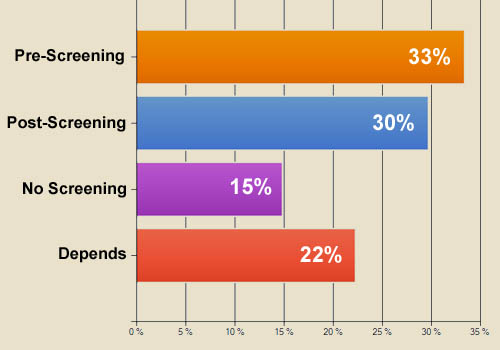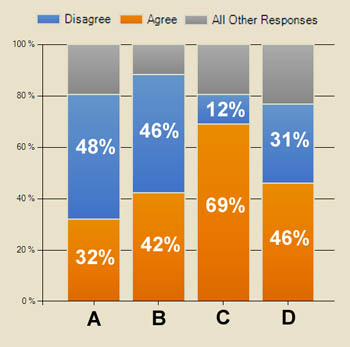Moderation of Pharma Social Media Discussions Survey
(Survey started 14 April 2010; N=31 respondents as of 31 January 2012)
 As more and more pharmaceutical companies launch social networking platforms associated with their brands, some will allow users (consumers, patients, and physicians) to post comments as part of ongoing discussions about drugs and/or the conditions they treat. Recent pharma experience with social media discussions (see See Resources & Further Reading below…) demonstrate how important it is to properly manage online communities. Perhaps the most important management tool is moderation.
As more and more pharmaceutical companies launch social networking platforms associated with their brands, some will allow users (consumers, patients, and physicians) to post comments as part of ongoing discussions about drugs and/or the conditions they treat. Recent pharma experience with social media discussions (see See Resources & Further Reading below…) demonstrate how important it is to properly manage online communities. Perhaps the most important management tool is moderation.
This survey asks your opinion of how pharmaceutical companies should moderate online discussions on sites that they own and/or control.
Consider a consumer/patient focused social network site that is owned and operated by a pharmaceutical company. It could be an “unbranded” disease information site or it can be a branded product support site. Visitors are allowed to submit comments to be posted to the site. The goal is to offer information and support through active discussions among site visitors and between visitors and the pharmaceutical company. The site’s terms and conditions specify what types of comments are acceptable and how they will be moderated.
Partial results are summarized in charts below. You can view a more detailed, complete and up-to-date online Summary of Responses plus view comments from respondents after taking the survey yourself: here.
Type of Moderation
Q: “To enforce the terms of use of the site, what type of moderation should be employed?” Respondents can choose from the following responses:
- Comments should be pre-screened BEFORE they are posted. (PRE-SCREENING)
- Comments should be post-screened; ie, examined AFTER they are automatically posted. (POST-SCREENING)
- There should be NO SCREENING at all
- It depends
Results to date are shown below. What’s your view? Take the survey and tell us (you can view up-to-date survey results plus comments after taking the survey here).

No Moderation
Q: “In the case where NO MODERATION is employed or possible, please indicate whether you agree, disagree, or have no opinion regarding the following statements.” Respondents can choose Agree, Disagree, It Depends, No Opinion. Statements:
- The company’s brand will suffer because of illegal, inappropriate, inaccurate, or misleading comments no matter what corrections are posted.
- Users will suffer because of exposure to illegal, inappropriate, inaccurate, or misleading comments no matter what corrections are posted.
- The company can always counteract/correct any illegal, inappropriate, inaccurate, or misleading comments with its own truthful statements.
- The community of users, apart from the company itself, will self-correct any illegal, inappropriate, inaccurate, or misleading comments.
Results to date are shown below. What’s your view? Take the survey and tell us (you can view up-to-date survey results plus comments after taking the survey here).

Pre-Screening
Q: “Please indicate whether you agree, disagree, or have no opinion regarding the following statements about PRE-SCREENING (screening BEFORE post is published).” Respondents can choose Agree, Disagree, It Depends, No Opinion. Statements:
- Prevents misinformation (including off-label drug information) from being published and then possibly propagated throughout the Internet.
- Keeps the site from being overrun by spam or other malicious posts.
- Requires too many resources (ie, FTEs) or nearly impossible to do in a timely fashion considering the 24/7 nature of online discussions.
- The delay — even a short delay — before posts appear will inhibit the use of the site and make it virtually useless.
Results to date are shown below. What’s your view? Take the survey and tell us (you can view up-to-date survey results plus comments after taking the survey here).
Post-Screening
Q: “Please indicate whether you agree, disagree, or have no opinion regarding the following statements about POST-SCREENING (moderation AFTER post is published).” Respondents can choose Agree, Disagree, It Depends, No Opinion. Statements:
- Review all new posts in a timely fashion (eg, within 48 hours).
- Before deleting posts, publish a response indicating that the post violates the terms and will be deleted.
- When posts are deleted, perform a “soft delete,” which shows that a post was deleted and why it was deleted.
- Do a “hard delete” (remove completely with no remaining record that the post existed).
Results to date are shown below. What’s your view? Take the survey and tell us (you can view up-to-date survey results plus comments after taking the survey here).
Addition Questions
In addition to the above questions, respondents were asked:
- When POST-SCREENING is used, how quickly should posts be approved/disapproved for publication?
- Whatever the type of moderation option used, who is the best choice for moderator?
What’s your view? Take the survey and tell us (you can view up-to-date survey results plus comments after taking the survey here).




![6 Digital Tools at the Center of Healthcare Digitalization [INFOGRAPHIC]](http://ec2-54-175-84-28.compute-1.amazonaws.com/pharma-mkting.com/wp-content/uploads/2021/04/6DigitalTools_600px-100x70.jpg)




